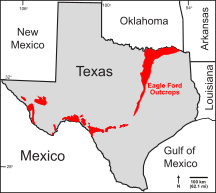This article may be too technical for most readers to understand. (January 2020) |
| Eagle Ford Group | |
|---|---|
| Stratigraphic range: Cenomanian-Turonian ~ | |
| Type | Group |
| Sub-units | Britton Formation, Arcadia Park Shale Formation, Lake Waco Formation, South Bosque Formation, Boquillas Formation |
| Underlies | Austin Chalk |
| Overlies | Woodbine Formation or Buda Limestone |
| Lithology | |
| Primary | Shale |
| Other | Marl, limestone, sandstone, volcanic ash beds |
| Location | |
| Region | Texas |
| Country | |
| Type section | |
| Named for | Eagle Ford, Texas[1] |
| Named by | Robert T. Hill[1] |
| Year defined | 1887 |
 | |


The Eagle Ford Group (also called the Eagle Ford Shale) is a sedimentary rock formation deposited during the Cenomanian and Turonian ages of the Late Cretaceous over much of the modern-day state of Texas. The Eagle Ford is predominantly composed of organic matter-rich fossiliferous marine shales and marls with interbedded thin limestones. It derives its name from outcrops on the banks of the West Fork of the Trinity River near the old community of Eagle Ford,[1] which is now a neighborhood within the city of Dallas. The Eagle Ford outcrop belt trends from the Oklahoma-Texas border southward to San Antonio, westward to the Rio Grande, Big Bend National Park, and the Quitman Mountains of West Texas.[2] It also occurs in the subsurface of East Texas and South Texas, where it is the source rock for oil found in the Woodbine, Austin Chalk, and the Buda Limestone,[3] and is produced unconventionally in South Texas and the "Eaglebine" play of East Texas.[4]
The Eagle Ford was one of the most actively drilled targets for unconventional oil and gas in the United States in 2010,[5] but its output had dropped sharply by 2015.[6] By the summer of 2016, Eagle Ford spending had dropped by two-thirds from $30 billion in 2014 to $10 billion, according to an analysis from the research firm Wood Mackenzie. This strike has been the hardest hit of any oil fields in the world. As of 2016, the spending was, however, expected to increase to $11.6 billion in 2017. A full recovery was not expected any time soon.[7]
Fossils are relatively common in Eagle Ford rocks. Fossilized Plesiosaurs, mosasaurs, Fish, shark teeth, crustaceans, sea urchins, feather stars, ammonites, oysters, clams, and other gastropod shells have all been found there.[8][9][10]
- ^ a b c "The American journal of science 3rd ser.:v.34 1887". HathiTrust. pp. 291–303. hdl:2027/coo.31924084352636. Retrieved 2024-06-03.
- ^ Denne, R. A., Breyer, J. A., Callender, A. D., Hinote, R. E., Kariminia, M., Kosanke, T. H., Kita, Z., Lees, J. A., Rowe, H., Spaw, J. M., and Tur, N. (2016). Biostratigraphic and geochemical constraints on the stratigraphy and depositional environments of the Eagle Ford and Woodbine Groups of Texas: "in" Breyer, J. A. (ed.), The Eagle Ford Shale: A renaissance in U.S. oil production, AAPG Memoir 110, pp. 1–86.
- ^ Surles, Jr., Milton A. (Spring 1987). "Stratigraphy of the Eagle Ford Group (Upper Cretaceous) and Its Source-Rock Potential in the East Texas Basin" (PDF). Baylor Geological Studies. Bulletin No. 45. Waco, Texas: Baylor Printing Service. Archived from the original (PDF) on June 3, 2024 – via Baylor University Department of Geosciences.
- ^ Hentz, T. F., Ambrose, W. A., and Smith, D. C. (2014). Eaglebine play of the southwestern East Texas basin: Stratigraphic and depositional framework of the Upper Cretaceous (Cenomanian-Turonian) Woodbine and Eagle Ford Groups: AAPG Bulletin, v. 98, p. 2551-2580.
- ^ Papa, Mark G. (2021-03-09). "Eagle Ford Shale - Eagle Ford Shale Map - Texas Oil & Gas". Archived from the original on March 9, 2021. Retrieved 2024-06-03.
- ^ Jennifer Hiller, "Hard Times Hit Eagle Ford," "San Antonio Express-News," January 3, 2016, pp. 1, A20
- ^ Jennifer Hiller, "Spending in Eagle Ford has dropped by 67 percent", "San Antonio Express-News," July 22, 2016, pp. 1, A6
- ^ Jacobs, L.L., Polcyn, M.J., Winkler, D.A., Myers, T.S., Kennedy, J.G., and Wagner, J.B. (2013) Late Cretaceous strata and vertebrate fossils of North Texas, "in" Hunt, B.B., and Catlos, E.J., eds., Late Cretaceous to Quaternary Strata and Fossils of Texas: Field Excursions Celebrating 125 Years of GSA and Texas Geology, GSA South-Central Section Meeting, Austin, Texas, April 2013: Geological Society of America Field Guide 30, p. 1–13, doi:10.1130/2013.0030(01)
- ^ Moreman, W. L. (1942) Paleontology of the Eagle Ford Group of north and central Texas: Journal of Paleontology, v. 16, p. 192–220.
- ^ Donovan, A. D., T. S. Staerker, A. Pramudito, W. Li, M. J. Corbett, C. M. Lowery, A. M. Romero, and R. D. Gardner (2012) The Eagle Ford outcrops of West Texas: Understanding heterogeneities within unconventional mudstone reservoirs: GCAGS Journal, v. 1, p. 162–185.
